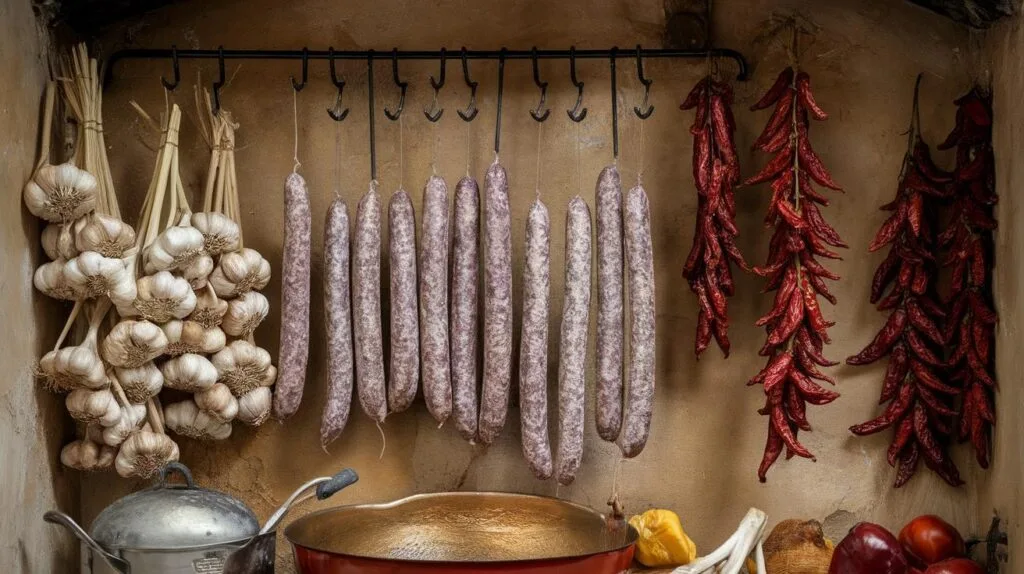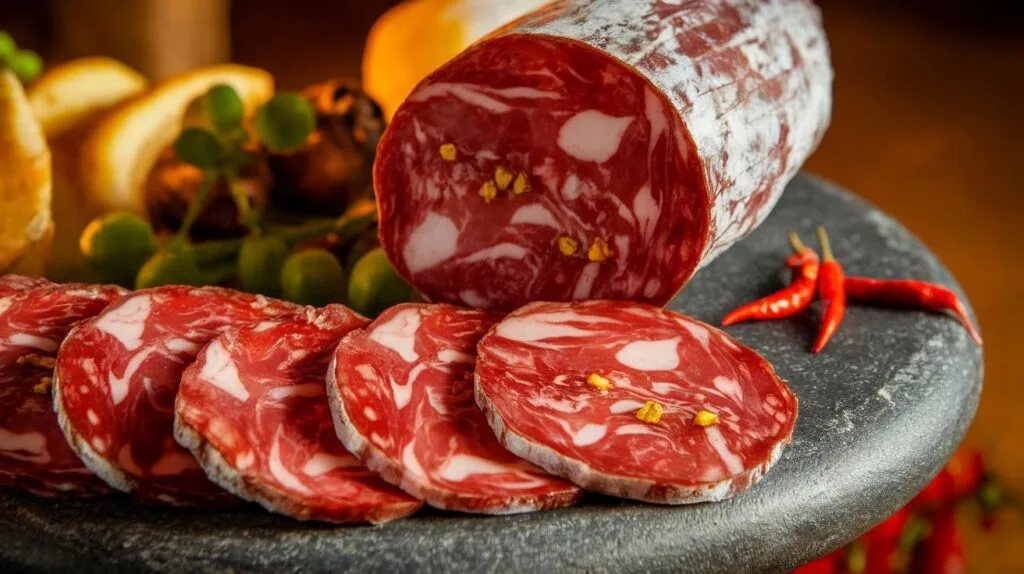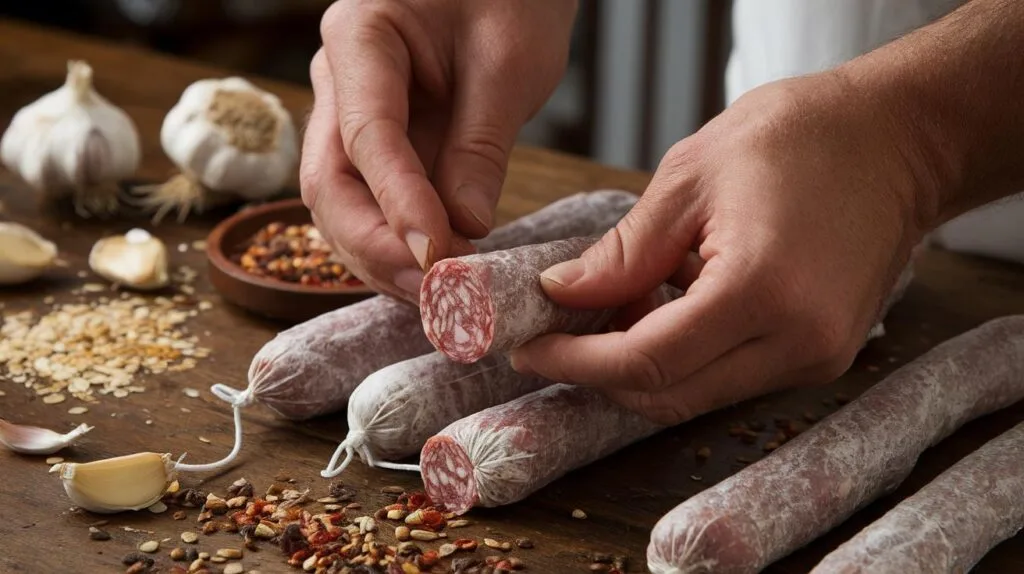When you think of traditional Italian cuisine, images of pasta, pizza, and fine wine might pop into your head. But there’s an unsung hero in Italy’s culinary landscape: Soppressata. This flavorful, cured meat has roots steeped in tradition and has made its way to the hearts (and stomachs) of people worldwide. Let’s dive deep into the world of Soppressata and uncover why it’s such a beloved delicacy.0
The Rich History of Soppressata
Soppressata’s Origins in Italy
Soppressata traces its roots back to southern Italy, particularly in regions like Calabria, Apulia, and Basilicata. It emerged from a need for preservation, long before refrigeration existed. Families would use curing as a way to store meat through the harsh winters, and Soppressata became a prized tradition passed down through generations.

In Calabria, the process of making Soppressata became almost an art form. Farmers and butchers would carefully select their pork, incorporating spices like chili peppers and fennel, which are abundant in the region. This attention to detail ensured the meat would not only last but also deliver a robust flavor that represented their local culture.
Cultural Significance of Soppressata
Soppressata isn’t just a food; it’s a symbol of heritage. Many Italians recall fond memories of grandparents preparing Soppressata in their kitchens, turning it into a family affair. It’s often served at special occasions and celebrations, embodying a sense of pride and community. Even today, in Italian-American households, Soppressata holds its status as more than just a cured meat—it’s a taste of home and tradition.
What is Soppressata?
Key Ingredients in Soppressata
So, what exactly makes Soppressata so special? It starts with the meat. While pork is the most common choice, variations made from beef or even wild boar exist. The meat is finely ground or coarsely chopped, depending on regional preferences, and seasoned with a mix of spices. The traditional ingredients include salt, black pepper, red chili flakes, garlic, and sometimes a splash of red wine.
How Soppressata Differs from Other Cured Meats
Soppressata often gets compared to salami, pepperoni, or capicola, but it has a character all its own. Unlike the tightly packed, uniformly round slices of salami, Soppressata typically has an irregular, flattened shape. This is due to its unique curing process, where the meat is pressed under heavy weights.
The flavor profile also sets it apart. Soppressata boasts a bold, slightly spicy taste that comes from its use of chili flakes. It’s less sweet than pepperoni and less smoky than capicola. Think of it as the bold cousin at the charcuterie table—distinctive, robust, and unforgettable.
Types of Soppressata
Calabrian Soppressata

Calabria’s take on Soppressata is fiery and intense. Known for its liberal use of chili peppers, Calabrian Soppressata packs a spicy punch that fans of heat adore. This version often includes a touch of smoked paprika, enhancing its bold flavor.
Apulian Soppressata
In Apulia, the Soppressata tends to lean on milder, subtler flavors. Here, the focus is on the natural richness of the pork, accented by aromatic fennel seeds. This variation pairs beautifully with soft cheeses and a glass of crisp white wine.
Regional Variations Across Italy
From Veneto in the north to Sicily in the south, almost every region has its spin on Soppressata. In some areas, it’s air-dried; in others, it’s lightly smoked. Some regions add nutmeg, while others favor a touch of orange zest. Each variation tells the story of its origins, showcasing the diversity of Italian culinary traditions.
The Art of Making Soppressata
Traditional Preparation Methods
Making Soppressata is a culinary art, combining tradition and precision. The process begins by selecting high-quality cuts of pork, which are blended with an array of spices like chili flakes, garlic, and fennel seeds. After being stuffed into natural casings, the sausage is pressed under heavy weights, creating its characteristic flattened shape. If you’re interested in experimenting with similar bold flavors, you might enjoy trying an authentic Crown Fried Chicken recipe that captures the essence of seasoning artistry.

The Role of Spices and Seasonings
Spices are the soul of Soppressata. Garlic adds depth, chili flakes bring heat, and fennel seeds or black pepper provide a delicate balance. Each bite is a symphony of flavors, reflecting the meticulous care taken during preparation.
Curing and Aging Process
Once pressed, Soppressata is left to cure. The curing process can last anywhere from one month to six months, depending on the desired flavor intensity. During this time, the meat develops its complex taste, as natural enzymes break down proteins and fats. It’s a waiting game—but oh, is it worth it!
Soppressata in Modern Cuisine
Pairing Soppressata with Wines and Cheeses
Soppressata’s robust flavor profile makes it a versatile ingredient in modern dishes. It can elevate a simple pasta dish, such as carbonara, with its smoky, spicy undertones. For a creative twist, consider pairing Soppressata with Mediterranean flavors, much like the vibrant ingredients used in a vegetable paella recipe. This combination creates a fusion of bold, earthy tastes that can redefine traditional meal prep.
When it comes to cheese, think creamy and mild to balance the meat’s intensity. A soft brie, fresh mozzarella, or a nutty Parmigiano-Reggiano can all elevate the experience. Add a few olives, some crusty bread, and a drizzle of olive oil, and you’ve got the perfect antipasto platter.

Soppressata in Recipes: From Appetizers to Main Dishes
While Soppressata is delightful on its own, its potential as an ingredient in various recipes shouldn’t be overlooked. Thinly sliced, it can transform a pizza or serve as a centerpiece in antipasto platters. For a lighter appetizer, you could pair it with fresh fruits, akin to the balance achieved in dishes like those mentioned in our guide to indulging in decadent desserts, which harmonize sweetness and richness.
For appetizers, consider wrapping Soppressata around melon slices or stuffing it into mushrooms for a savory bite-sized treat. It’s also an excellent addition to pasta dishes, offering a flavorful boost to carbonara or arrabbiata.
Feeling adventurous? Dice up Soppressata and add it to a frittata or omelet. The cured meat adds a rich depth that’s perfect for breakfast or brunch. Its versatility ensures that Soppressata can find a place in any meal, whether casual or sophisticated.
Health Benefits and Considerations of Soppressata
When it comes to cured meats, Soppressata is a versatile choice that enhances a variety of dishes. For instance, you could wrap it around melon slices for a simple appetizer or stuff it into mushrooms for a bite-sized treat. Additionally, it’s a delightful addition to pasta recipes, such as carbonara or arrabbiata, adding depth to every bite.
If you’re feeling adventurous, try chopping it up and mixing it into a frittata or omelet. This cured meat lends a rich flavor that’s perfect for breakfast or brunch, proving its place in meals both casual and sophisticated.
Nutritional Value and Considerations
Soppressata is not just about flavor—it’s also packed with nutrients. Rich in protein and essential vitamins like B12 and iron, it provides a solid boost of energy. While its fat content is notable, it also includes healthy fats that support energy and overall cell health.
However, like many cured meats, moderation is key. Due to the curing process, which relies on salt, sodium levels can be high. To maintain a balanced diet, consider pairing it with fresh fruits and vegetables. This approach not only enhances your meal but also supports your overall health.
Tips for Dietary Balance
If you’re monitoring sodium intake, pairing Soppressata with fresh vegetables is an excellent way to create a balanced meal. Think of dishes like hearty soups or stews, but take note of what to avoid for optimal results. For instance, our guide on what not to put in a soup maker offers valuable tips to ensure you preserve the natural flavors of your ingredients while maintaining their nutritional integrity.
FAQs
How does Soppressata differ from salami?
Although Soppressata and salami are both cured meats, their distinctions are worth noting. Soppressata is often pressed, giving it a flatter shape, while salami typically maintains a cylindrical form. Flavor-wise, Soppressata often has a more robust and spiced profile, thanks to the inclusion of chili flakes, whereas salami leans toward a milder and sometimes sweeter taste.
How do you pronounce Soppressata?
Pronouncing Soppressata might seem tricky at first, but it’s quite simple: soh-preh-SAHT-tah. The emphasis falls on the third syllable, rolling smoothly off the tongue. Impress your friends by confidently saying it the next time you order it at a deli!
Is Soppressata like Capicola?
Soppressata and Capicola are both Italian cured meats, but they’re distinct in texture, flavor, and preparation. Capicola is made from the neck or shoulder of the pig, giving it a marbled, tender texture. Soppressata, on the other hand, uses pork cuts like the thigh or shoulder and is pressed during curing, creating its signature flat shape.
What does Soppressata taste like?
Soppressata is a bold symphony of flavors. It’s savory, with a hint of spice from chili flakes and a touch of garlic and fennel. The aging process adds a subtle tanginess, making every bite a balance of rich, spicy, and slightly smoky notes.
Soppressata Around the World
Soppressata’s Role in Italian-American Cuisine
Italian immigrants brought their love for Soppressata to America, where it quickly gained popularity. Today, it’s a staple in Italian-American households, often served at family gatherings or as part of festive charcuterie boards.
What’s fascinating is how Soppressata has become a symbol of cultural pride. In cities like New York and Chicago, Italian delis proudly display it alongside other traditional meats, bridging the gap between old-world traditions and modern tastes.
Global Adaptations of Soppressata
While Soppressata remains quintessentially Italian, its influence has inspired variations worldwide. In Spain, you might find similar cured meats like chorizo taking cues from Soppressata’s bold flavors. Even in countries like the United States, artisan butchers are experimenting with new spices and techniques to put a modern spin on this classic cured meat.

Common Problems and Solutions When Making Soppressata
Troubleshooting Curing and Aging Issues
Making Soppressata at home can be incredibly rewarding, but it’s not without its challenges. One common problem is uneven curing, which can result in pockets of overly dry or overly moist meat. To avoid this, ensure that your curing environment has consistent humidity and temperature levels.
Another issue is mold development. While certain white molds are safe and even beneficial, black or green mold can spoil the meat. Regularly inspect your’s during curing, and wipe it down with a vinegar solution if you notice unwanted mold.
Finding the Best Soppressata Substitutes
If Italian cured meats aren’t available, don’t worry—you’ve got plenty of options! For a similar flavor profile, spicy salami or Spanish chorizo can work as great alternatives. If you need a pork-free choice, beef-based cured meats like bresaola are a solid option. While these may not perfectly replicate the bold flavors of Italian specialties, they still deliver a satisfying burst of taste.
Soppressata vs. Salami
Italian cured meats and salami are like cousins at a family gathering—similar yet distinct. One of the key differences lies in their texture and shape. Italian meats are often pressed during curing, giving them a flattened, rustic look, while salami tends to have a cylindrical form.
In terms of flavor, the Italian variety is often spicier and bolder, thanks to the addition of chili flakes and garlic. Salami, on the other hand, usually has a milder, sweeter taste, sometimes enhanced with hints of wine or cinnamon. For those who enjoy a flavorful kick, the spicier cured meats are a great choice, while salami suits those seeking a more balanced taste.
Soppressata vs. Pepperoni
Pepperoni is a pizza favorite across the globe, but how does it compare to traditional Italian meats? While both are seasoned and cured, pepperoni typically has a smokier and tangier flavor, softer texture, and a tendency to release oils when cooked. This makes it perfect as a pizza topping.
By contrast, Italian meats have a more complex flavor profile and are less oily. They bring a natural richness that makes them perfect as a snack or a centerpiece on a charcuterie board.
Soppressata vs. Capicola
Capicola, sometimes called “gabagool” in Italian-American culture, is a cured meat made from the neck or shoulder of the pig. It is leaner than many other Italian cured meats and has a tender, silky texture. While capicola boasts a milder seasoning that highlights the meat’s natural flavor, its pressed counterpart is bolder and spicier.
Both are delicious, but they serve different purposes. The spicier, cured options are ideal for those who crave bold and fiery flavors, while capicola is better suited for those who prefer a refined and delicate experience.


